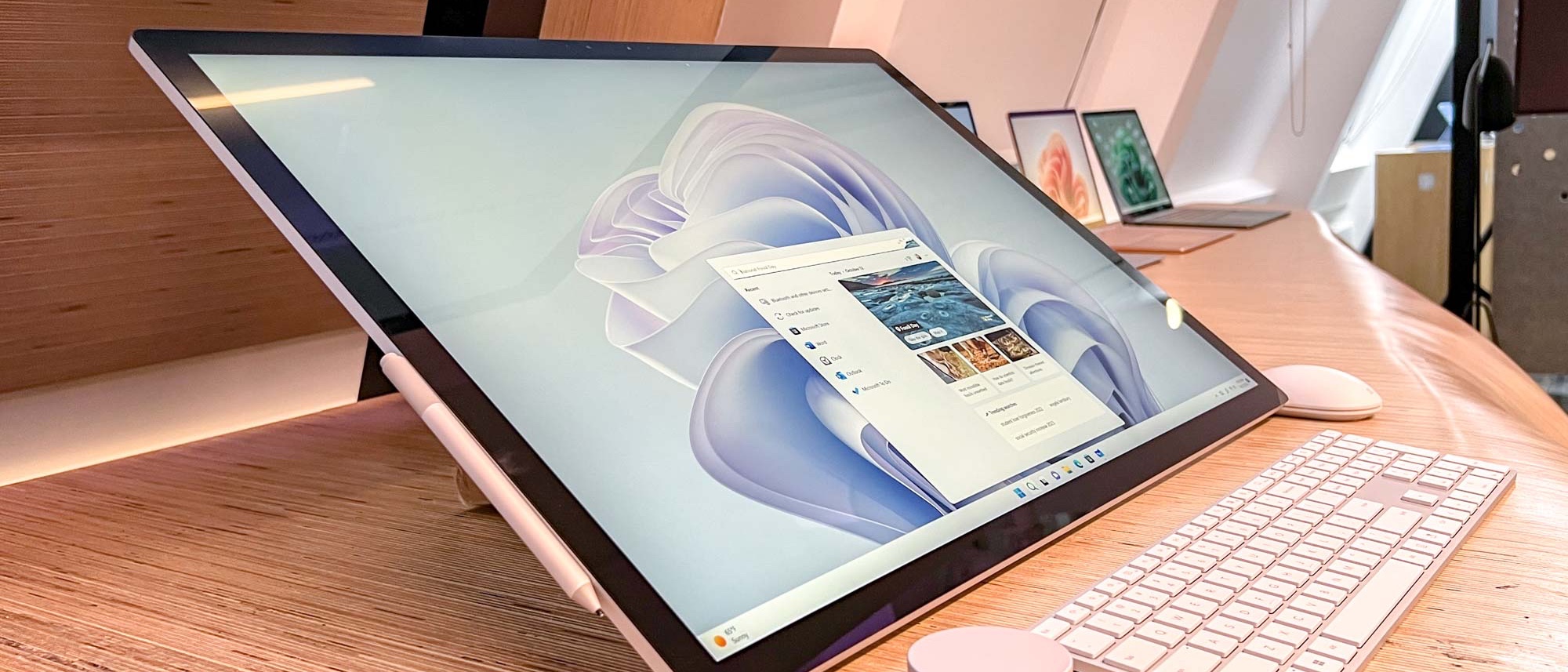Early Verdict
The Microsoft Surface Studio 2+ doesn't reinvent the wheel but it has the makings of being an excellent all-in-one computer — provided you can afford it.
Pros
- +
Large 28-inch screen
- +
"Zero gravity" hinge makes it easy to position screen
- +
Suitable for everyday work and artistic projects
Cons
- -
Outdated components
- -
Steep price
Why you can trust Tom's Guide
The Microsoft Surface Studio 2+ was the biggest surprise to come out of the October 12 Microsoft Surface event. I say this not only because of the all-in-one computer’s ginormous size, but because we haven’t seen a new Studio device since 2018's Surface Studio 2.
Despite the four-year gap, things remain relatively the same in terms of the new Surface Studio's design. But updated internal components make this a more powerful all-in-one than its predecessors.
With a 28-inch 4K+ (4,500 x 3,000) touchscreen and an Nvidia GeForce RTX 3060 laptop GPU, the Surface Studio 2+ is meant to be a playground for creatives. Plus, it looks like Microsoft includes a Surface Pen stylus in the box — a must-have for a creative tool like this.
But outside of those specs, the Surface Studio 2+ comes across as a solid device for everyday computing and perhaps even some intensive gaming due to the RTX 30 series GPU.
I got some brief hands-on time with the Surface Studio 2+ at the aforementioned Microsoft event and felt it was the most impressive machine at the show. That isn’t to say the Microsoft Surface Pro 9 or Microsoft Surface Laptop 5 weren’t intriguing, but the Surface Studio 2+ is a computer I’d personally like to own… even if it costs an eye-watering $4,299 / AU$7,279.
Below, I’ll detail everything you need to know about the Microsoft Surface Studio 2+ and what I thought of the new all-in-one.
Microsoft Surface Studio 2+: Price and availability
The Microsoft Surface Studio 2+ will be available on October 25 for a starting price of $4,299. For that you get a 28-inch screen, an 11th gen Intel Core i7-11370H processor, an Nvidia GeForce RTX 3060 laptop GPU, 32GB of RAM and 1TB of SSD storage.
Get instant access to breaking news, the hottest reviews, great deals and helpful tips.
Microsoft Surface Studio 2+: Design
The Surface Studio 2+ is virtually identical to previous iterations of Microsoft's all-in-one. This isn’t a negative since its design is extremely well-refined. It’s fitting that an all-in-one you can create art on is itself a work of art, design-wise. Images can’t do this machine justice. It’s a marvel of design.
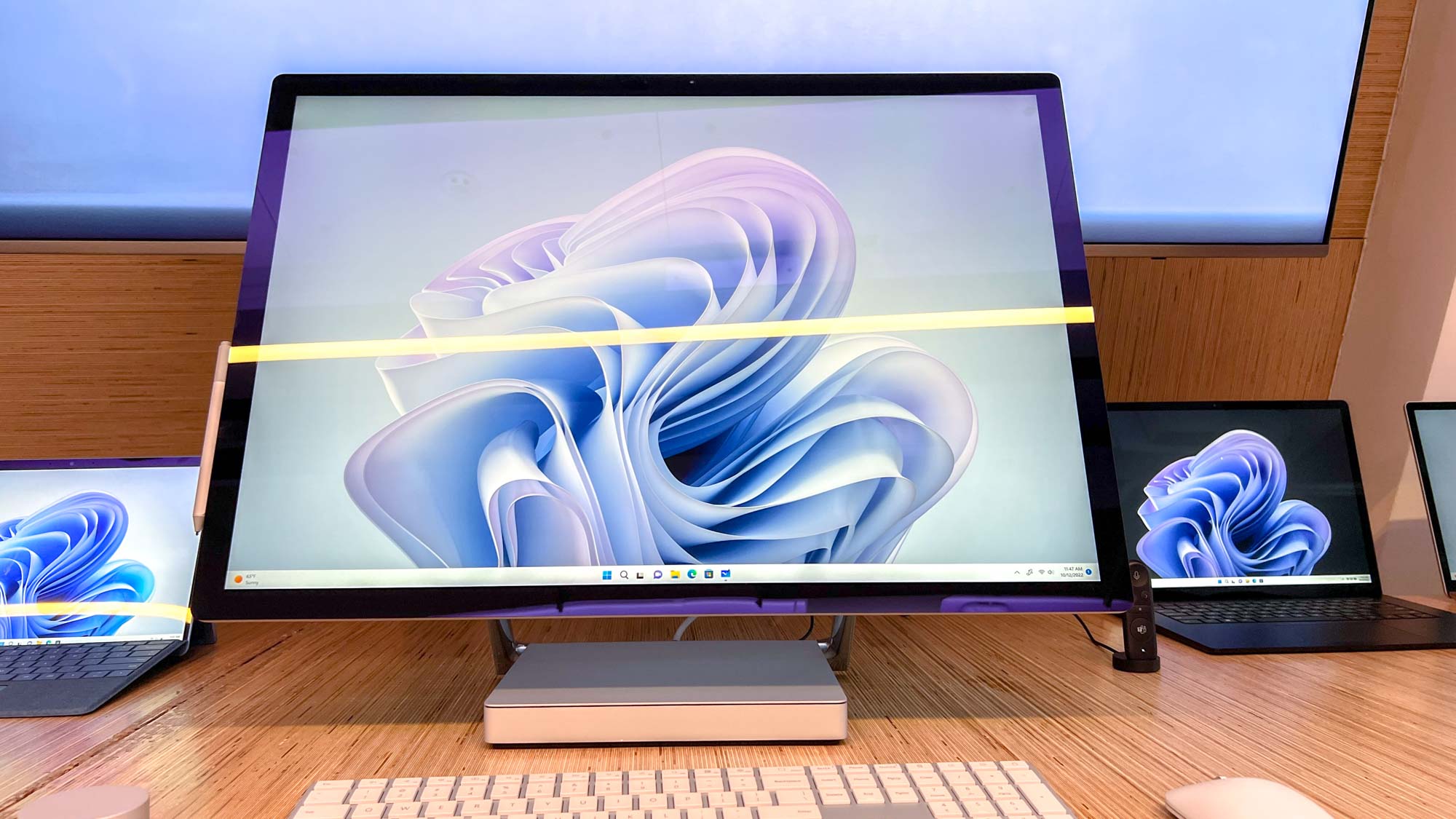
The 28-inch touch-screen panel is mounted on what Microsoft calls a "zero gravity hinge." What’s great about this spring-assisted, dual-hinge stand is that it allows you to put the screen upright for traditional desktop use or lower it entirely so you can use the stylus and touch screen more comfortably. The latter is especially useful for artists since you can position the device similarly to a drafting table.
You’ll find that the Surface Studio 2+ has all of its PC components housed in the base of the stand. As before, the base is square with rounded corners and a rounded rear end that has all of the computer’s ports. The base is sturdy enough to keep the computer in place as you move the display up or down.
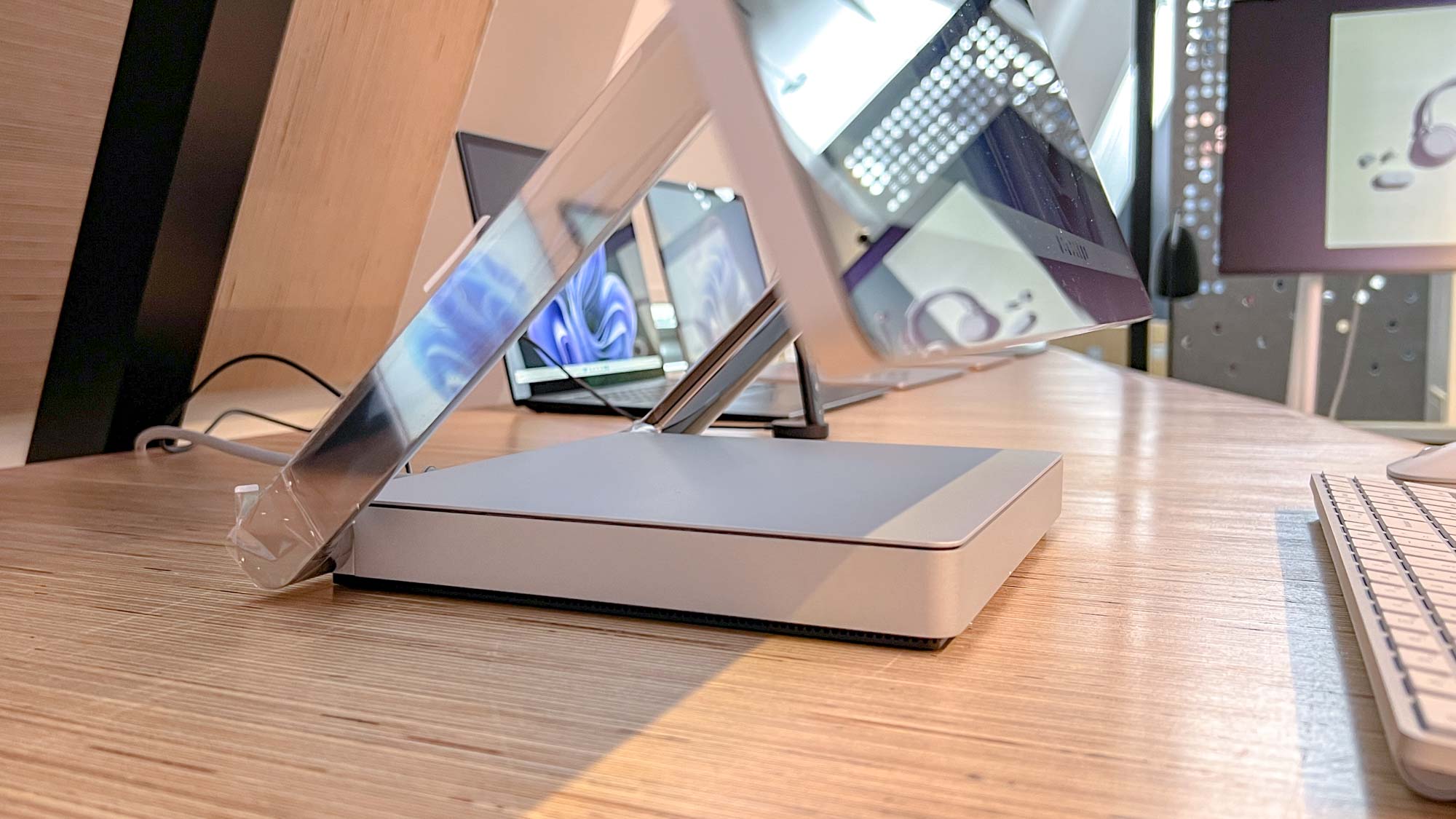
Microsoft Surface Studio 2+: Ports
The Surface Studio 2+ has a generous number of ports that should suit all of your needs. This includes three Thunderbolt 4/USB-C ports, two USB-A ports, a 3.5mm headphone jack and an Ethernet port.
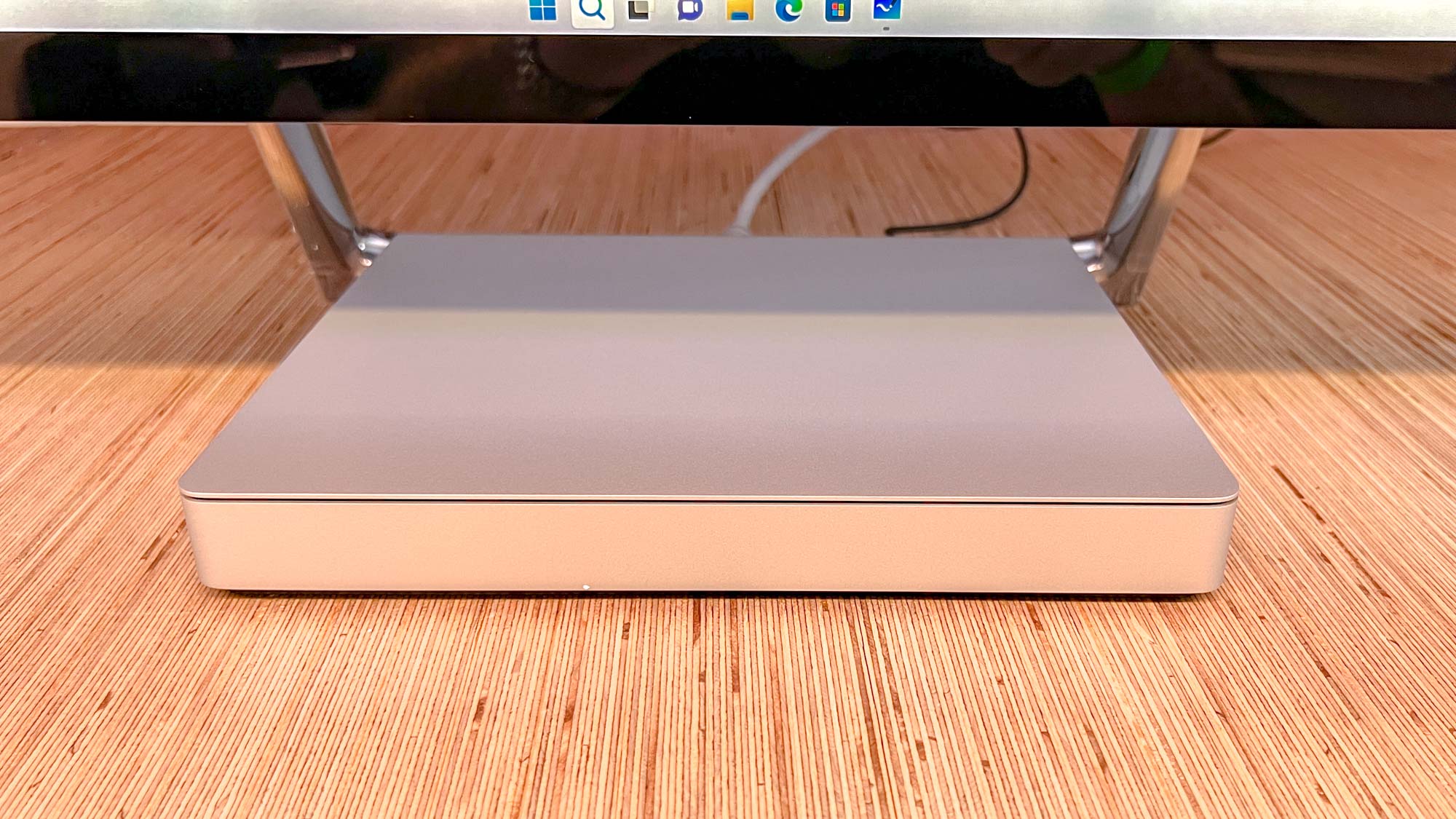
In our review of the Surface Studio 2, we stated our displeasure with port placement. With all of the ports on the back of the machine, and with the unusual curved surface on that rear panel, the Surface Studio's ports were hard to reach and made it more difficult than usual to blindly plug things in.
The computer I checked out only had a power cable coming out of the back and it would have been rude of me to stick something into one of the available ports at an event. Because of that, I can’t say whether or not it’s difficult to plug cables into the ports. I’ll see for myself when I review the Surface Studio 2+.
Microsoft Surface Studio 2+: Display
The Surface Studio 2+ has a 28-inch PixelSense display with a 3:2 aspect ratio and 4500 x 3000 resolution. A screen that size absolutely commands your attention. The model at the show only had the standard Windows 11 desktop on the screen but I can only imagine how impressive streaming content will look on such a huge screen.
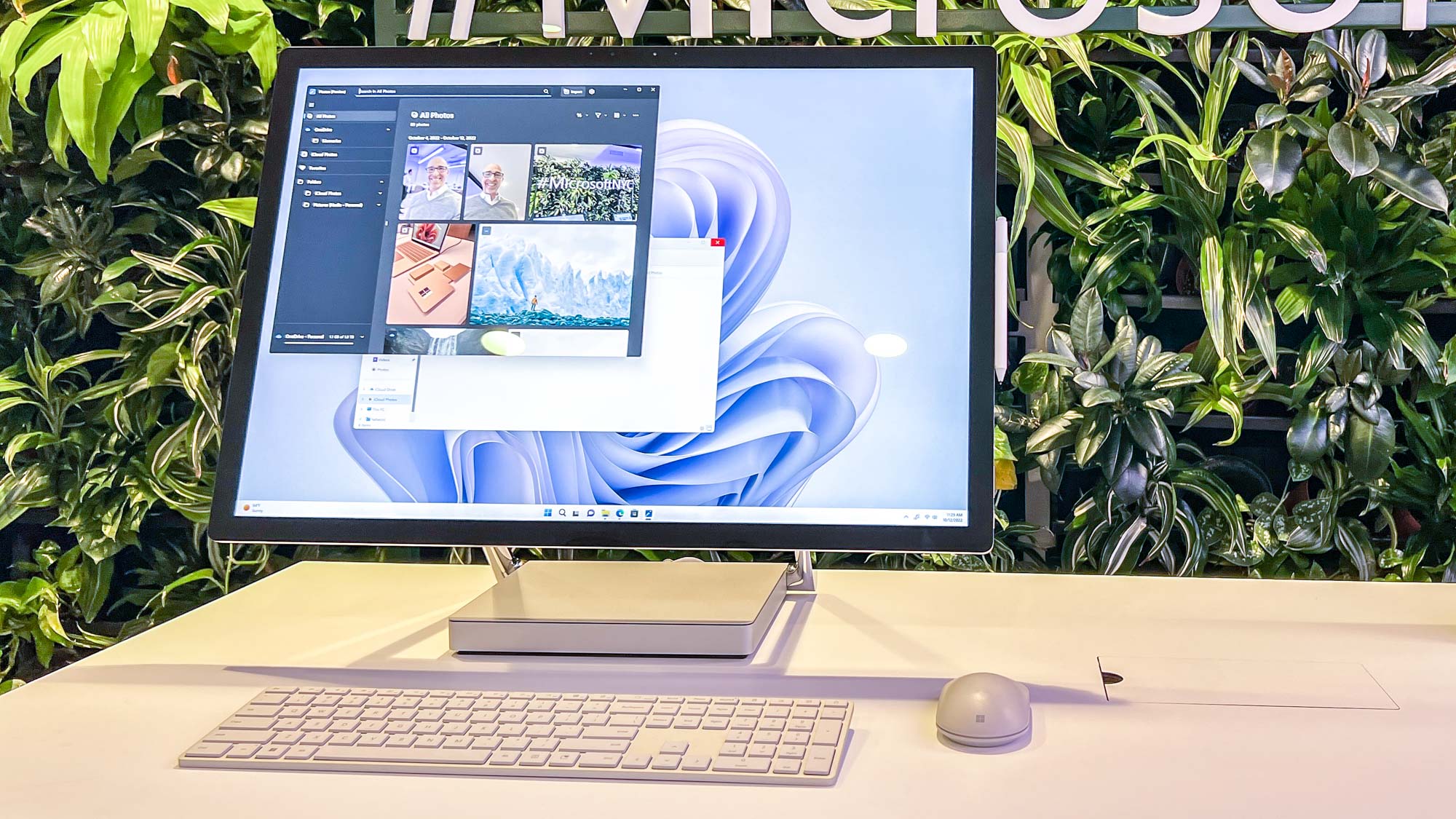
As before, each display is color calibrated before it's shipped, meaning that display quality is at its best right out of the box. Built-in color settings are optimized for sRGB, DCI-P3 and Vivid color modes. The previous model lacked true HDR capability. It’s unclear if the Surface Studio 2+ has true HDR, though it should be possible to run a secondary display (via USB-C) that outputs HDR-enabled video.
I used the stylus pen to write on the screen and found the act relatively smooth. I say relatively because writing on a screen is still something I’m not used to. Despite my issues with digital writing, I’m sure professional artists will find the large screen easy to work on.
Microsoft Surface Studio 2+: Performance
The Surface Studio 2+ packs an 11th gen Intel Core i7-11370H CPU, an Nvidia GeForce RTX 3060 laptop GPU, 32GB of RAM and a 1TB SSD.
According to Microsoft, the Surface Studio 2+ enjoys up to 50% faster CPU speed than the Surface Studio 2 and is five times more powerful than the original Studio. Microsoft also says the new all-in-one has double the graphics performance of the Surface Studio 2.

I don’t doubt Microsoft’s claims of the new Surface Studio 2+ being more powerful than its predecessors. After all, the Surface Studio 2+ uses an 11th gen Core CPU, which should outperform the Surface Studio 2 which was powered by a 7th gen Intel processor. With that said, it’s still surprising that a brand-new machine released in 2022 packs a CPU that’s a generation old — or two generations old if you account for the upcoming 13th gen Intel Core Raptor Lake processors. The RTX 3060 is also now a last-gen GPU since the RTX 40-series has begun rolling out. But I’m expecting Nvidia’s latest graphics cards to become ubiquitous in Windows PCs so soon.
We’ll put the Surface Studio 2+ through our litany of benchmark tests to determine if its outdated internals hinder its performance.
Microsoft Surface Studio 2+: Outlook
The Microsoft Surface Studio 2+ has many of the same features that placed the previous models in our best all-in-one and best computers lists. The huge 28-inch screen is quite a sight to behold and the zero gravity hinge makes it extremely easy to position the Surface Studio's screen to suit your needs. Whether you plan to do regular computing or want to use this device to bring your artistic creations to life, the Surface Studio 2+ has the makings of being an overall solid device.
Despite its virtues, though, I still have some reservations about the Surface Studio 2+. The main thing I’m concerned about is the computer’s performance due to its outdated specs. Perhaps it's powerful enough for what it’s intended for, but a tech nerd like me can’t help but raise an eyebrow when I see what this machine is packing. And the fact the whole thing is $4,299 makes me even more skeptical.
We expect to review the Microsoft Surface Studio 2+ in the near future. When that happens, we’ll compare it to its predecessor and similar devices on the market.

Tony is a computing writer at Tom’s Guide covering laptops, tablets, Windows, and iOS. During his off-hours, Tony enjoys reading comic books, playing video games, reading speculative fiction novels, and spending too much time on X/Twitter. His non-nerdy pursuits involve attending Hard Rock/Heavy Metal concerts and going to NYC bars with friends and colleagues. His work has appeared in publications such as Laptop Mag, PC Mag, and various independent gaming sites.
